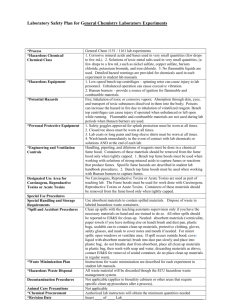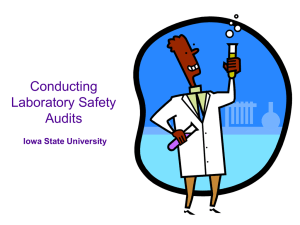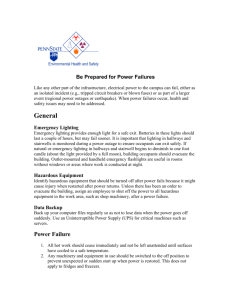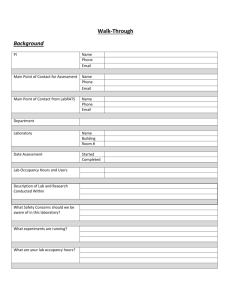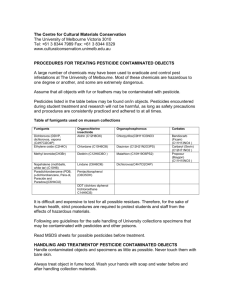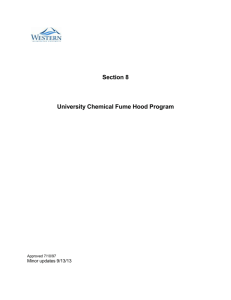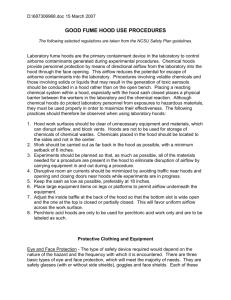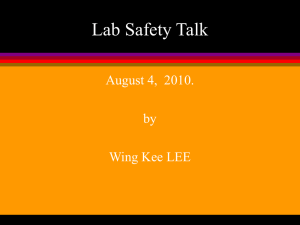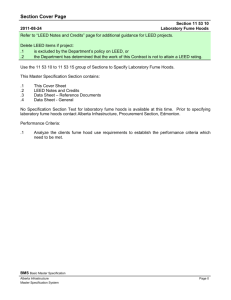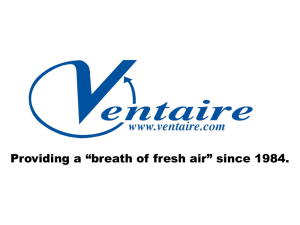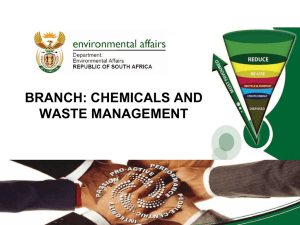Laboratory Safety
advertisement
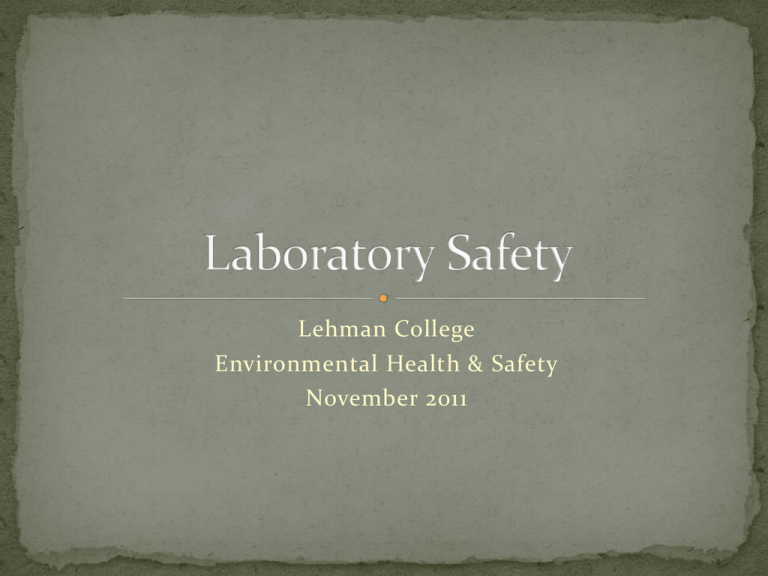
Lehman College Environmental Health & Safety November 2011 Regulatory agencies and laboratory safety 2 Occupational Safety & Health Administration New York State Department of Labor Public Employees Safety & Health New York City Fire Department (NYS DOH, NYC DOHMH – Radiation Safety) City University of New York 3 OSHA Lab Standard adopted by NYS PESH Written plan for protecting employees from chemical exposure Elements of the Chemical Hygiene Plan: Employee exposure monitoring Training Medical consultation Hazard identification Respirator use Fume hoods Recordkeeping 4 Updated (2008) regulations for fire prevention in nonproduction chemical laboratories Covers all academic labs: elementary, high school, college, hospital, research, etc. C14 Certificate of Fitness based on these new regulations 5 Labs are inspected by FDNY starting in January Labs must be in compliance with FDNY regulations FDNY inspector may also cite other types of violations not specifically covered by regulations Violation orders must be corrected before new permit can be issued 6 Federal EPA regulations for hazardous waste All hazardous waste is disposed through Environmental Health and Safety No drain disposal of hazardous materials EVER! Environmental requirements Composite of federal, state, NYC, other environmental regs Aspects of the EMS relevant to labs will be covered in the next unit, Hazardous Waste Also covers petroleum, air emissions, pesticides Reporting requirements, training, inspections procedures 8 Lehman EH&S CUNY EH&S NYC Dept of Environmental Protection Environmental Protection Agency More about inspections later 9 What are the chemical and physical hazards in the lab? 10 Chemical hazards: Flammable Corrosive Reactive Toxic Can be a combination of one or more hazard classes Physical hazards: Electrical Cryogenic (lasers) (radioactive) Flashpoint < 100F (FDNY) Flashpoint: “the lowest temp at which a liquid emits enough vapor to form an ignitable mixture in air” Incompatibilities: oxidizers, acids Flammable storage limits: 15 gallons per lab (FDNY) Ex. – most nonhalogenated organic solvents (alcohols, benzene, alkanes, alkenes, alkynes; ethers; dichloroethane; etc. etc. etc.) Flammable materials (liquids) must be stored in flammable- or explosionproof refrigerators only “No flammables flashing <100F” signs are posted on “Regular” lab refrigerators (FDNY) Cool flammable liquids in dry ice/acetone or ice bath instead Causes fire upon exposure to air, water, or spontaneous chemical reaction white phosphorus Alkali metals Finely-divided metals Nitrocellulose Dinitro-, trinitro compounds Organic peroxides FDNY storage limit: 2 lbs Form explosive mixtures in air: Hydrogen Carbon monoxide Part of ongoing processes only Connected to equipment requiring flam gas use one cylinder in use, plus one cylinder in reserve Store separate from oxidizing gases Liquids (Solids) Gases Physical form must also be considered when evaluating the degree of hazard Most commonly encountered in the lab Acids: hydrochloric, sulfuric, nitric, perchloric, (hydrofluoric) Bases: NaOH, KOH; base bath Organic solvents Even non-fuming types tend to fume Always work in a fume hood Wear gloves, goggles, labcoat More seriously hazardous than liquids or solids Respiratory tract as well as surface tissues vulnerable Region of respiratory tract affected is directly related to degree of water solubility High solubility: HCl, HF - upper respiratory tract Medium solubility: Cl, oxides of N - bronchi Low solubility: phosgene - alveoli Everything is toxic; the dose makes the poison Local or systemic effect Route of entry Target organ Types of toxic effects Irritant Sensitizer/allergen Carcinogen Mutagen Please limit the amounts of chemicals to your immediate needs Do not stockpile chemicals old chemicals = inherently waste-like , when stored with newer chemicals of the same type Test peroxidizable chemicals every 6 months Inspect electrical equipment for frayed cords, exposed wires Intact or damaged equipment = spark source Repair/replace worn electrical equipment! Post High Voltage signs at electrophoresis setups and power supplies When working with flammables, use intrinsically safe electrical equipment only Administrative controls Engineering controls Personal Protective Equipment 22 Administrative controls Employee information and training Material Safety Data Sheets (MSDS) lab inspections by EH&S, others Engineering controls Chemical fume hoods Personal Protective Equipment - PPE Eye protection Protective clothing (labcoats, gloves) Respiratory protection Chemical hazard information supplied by the manufacturer (OSHA) MSDS accompanies each chemical shipment Required for both pure chemicals and chemical products (mixtures) containing hazardous chemicals All hazardous components >1% Exact percent composition not required Read MSDSs from many different sources for a single chemical for a more complete understanding of hazard Engineering controls (fume hoods) are the first line of defense against hazardous chemical exposure Hazard is removed from worker environment Laboratory air is not recirculated; air is exhausted directly to the outdoors through the fume hoods Proper fume hood use minimizes/eliminates chemical exposures Not for worker protection Most laminar flow hoods protect the product from contamination only Draws in HEPA-filtered air from lab to make a “curtain” of air through the front opening blows HEPA-filtered air out through top Not for use with hazardous materials (chemical vapors pass through HEPA filter) 27 Turn fume hood ON Check for airflow by holding a kimwipe or tissue at the hood face Work at least 6” inside hood to ensure capture of chemical vapors Lower the sash to 12-18” for proper face velocity, to protect the breathing zone, and provide splash protection Used for procedures in which perchloric acid is boiled to near-dryness Perchlorate salts settle on hood surfaces, ducts Reacts violently with organic materials Washdown feature rinses interior surfaces Single ducted (not combined with other fume hoods) Perchlorates crystalizing on fume hood duct 29 100 feet/minute air Close fume hood sash velocity is easily disrupted Fume hoods should be located away from doors, walkways Clutter in fume hoods affects airflow Raise large equipment on jacks to allow proper airflow when not in use Fume hoods are intended for worker protection, not chemical storage PPE is the last line of Latex exam gloves defense against chemical exposure Required PPE for all persons working in labs: rapidly degraded by many chemicals Nitrile gloves provide greater protection Eye protection Gloves labcoat Check MSDS for proper glove selection Not recommended! Re-examine procedures and work practices before resorting to respiratory protection Do not obtain a respirator on your own Contact EHS for evaluation If respirator use is warranted, Lehman will provide equipment, training, medical consultation, etc. etc. etc. Chemical splash on body: minimize duration of contact = minimize injury Use only water to remove chemicals Know the location(s) of the emergency eyewash and shower BEFORE anything happens Do not hesitate to use! FLOOD affected area for 15 minutes, then contact Public Safety or EHS Public Safety Environmental Health & Safety office X7777 X8988 APEX 109 Music Building, room All hours B37A Working hours, 9am – 5 pm After hours, EHS personnel will be contacted by Public Safety After hours, Public Safety will contact EHS personnel Small spills are cleaned Contact Public Safety up by lab personnel Larger spills, or uncontained spills of more hazardous materials are handled by CUNY’s HazWaste contractor x7777, or EHS x8988 Describe nature of the spill (chemical name, amount, exact location of spill) Depending on the nature of the spill, you may be asked to evacuate the lab/floor/building Who conducts inspections? What do lab personnel need to do? 36 Lehman EH&S: all areas CUNY EH&S: all areas in which potential environmental hazards exist NYC Dept of Environmental Protection: chemical storage rooms Environmental Protection Agency: all areas in which potential environmental hazards exist 37 Flammable storage over FDNY limit (15 gallons for most labs) Inadequate Certificate of Fitness coverage Peroxide-forming chemicals not labeled with their opening dates Incompatible chemicals stored together Housekeeping issues… 38 What’s wrong with this picture? Unlabeled (waste?) containers Al-foil used as container caps 5-Gallon waste container is too large for HazWaste collection (would take years to fill) 39 What’s wrong with this picture? Oxidizer (NaNO2) stored with organics 40 What’s wrong with this picture? Unlabeled (waste? reagent? sample?) container 41 What’s wrong with this picture? Al-foil used as container caps Tubing does not make a good seal with bottle Tubing does not make a good seal with waste containers 42 Colleges and Universities have always been subject to EPA regulations, but have been inspected by EPA only since the mid-1990s CUNY-EPA Audit Disclosure agreement, 2005-2010 EPA agreed to not audit CUNY campuses, but CUNY EHSRM must perform environmental audits Most senior colleges have been inspected by EPA by October 2011 EPA expected to continue with inspections at CUNY 43 Lehman College has not yet been inspected by EPA EPA focus: hazardous waste, chemical inventory issues At other colleges (CUNY and others), issues of laboratory housekeeping have been cited 44
